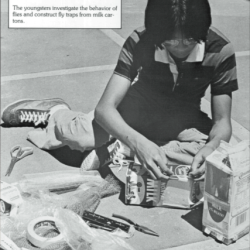Source Institutions
Source Institutions
Add to list Go to activity
Activity link broken? See if it's at the internet archive

In this activity, learners observe fly behavior and then build a flytrap. They make more observations, compare the effectiveness of different traps, and modify their traps to increase their effectiveness. In doing so, learners consider what variables make for an effective trap as well as learning how to study the behavior of an animal. Even pesky flies provide an interesting challenge.
- 45 to 60 minutes
- 1 to 2 hours
- $1 - $5 per group of students
- Ages 11 - adult
- Activity
- English
Quick Guide
Materials List (per group of students)
- 1 piece of fly bait: "ripe" fish, meat, guts, or other fly-attracting food
- 1 milk carton (half-gallon size)
- water to keep the bait moist
- window screen (nylon is best): enough for each kid to cover the long side of a milk carton
- straws
- paper plates
- plastic wrap
- aluminum foil
- tape
- popsicle sticks
- rubber cement
- string
- cheesecloth
- cone-shaped cups
- scissors
- paring knives
- stapler
Subjects
-
Life Sciences
-
Diversity of Life
- Animals
-
Diversity of Life
-
The Nature of Technology
-
The Design Process
- Invention and Innovation
- Problem Solving
-
The Design Process
Informal Categories
- Animals
- Nature and Environment
- Outdoor Activity
Audience
To use this activity, learners need to:
- see
- touch
Learning styles supported:
- Uses STEM to solve real-world problems
- Involves hands-on or lab activities
Other
This resource is part of:
Access Rights:
- Free access
By:
Rights:
- All rights reserved, The Regents of the University of California, 1979
Funding Source:
- National Science Foundation, SED 72-08523
